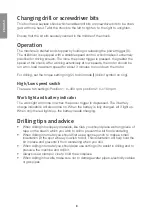
4
EN
GL
IS
H
3) Personal safety
a) Pay attention to your actions and use common sense when using power tools.
Never use power tools if you are tired or under the influence of drugs, alcohol or
medication. One moment of inattention while using a power tool may result in
serious injury.
b) Use protective equipment. Always wear safety glasses. Using protective clothing
such as dust masks, non-slip safety shoes, helmets and ear defenders when
needed decreases the risk of injury.
c) Avoid accidental starts. Make sure that the power switch is set to OFF before
plugging the tool into a wall socket. Never carry a power tool with your finger on
the trigger and never connect the power tool to a wall socket when the switch is
set to ON, since it may result in injury.
d) Remove all service tools/keys before switching on the power tool. A service tool
left on a moving part of the power tool may result in injury.
e) Do not overreach. Make sure you stand steady and well balanced at all times.
This will allow you to have more control in unexpected situations.
f) Wear suitable clothing. Do not wear loose-fitting clothing or jewellery. Keep hair,
clothes and gloves away from moving parts. Loose-fitting clothes, jewellery or
long hair could become caught in moving parts.
g) If equipment for dust extraction or collection is available, make sure that it
is connected and used properly. Using technical aids may decrease dust
related hazards.
4) Use and maintenance of power tools
a) Do not force the power tool. Use a power tool suitable for the work you are about
to perform. The proper power tool will perform the task better and safer if used at
the correct feed rate.
b) Never use the power tool if the power switch does not switch the tool on and
off properly. All power tools that cannot be controlled by the power switch are
dangerous and must be repaired.
c) Unplug the lead from the wall socket before making any adjustments, changing
accessories or storing the power tool. These precautions reduce the risk of the
power tool starting unexpectedly.
d) Store any power tools that are not being used out of children’s reach. Do not
allow people who are unfamiliar with the tool or its functions to operate the tool.
Power tools can be dangerous if they fall into the hands of inexperienced users.
e) Maintaining power tools. Check for any incorrect settings, parts that catch,
broken parts or anything else which may cause the power tool to malfunction.
If something is damaged it must be repaired before use. Many accidents are
caused by poorly maintained power tools.
f) Keep tools sharp and clean. Properly maintained cutting tools with sharp blades
are less likely to jam and are easier to control.
g) Use the power tool, accessories and similar according to the instructions and in an
appropriate way suitable for the type of power tool used. Also take into consideration
your work environment and the type of work to be done. Using the power tool for
a purpose other than that for which it is intended could result in a dangerous situation.





































